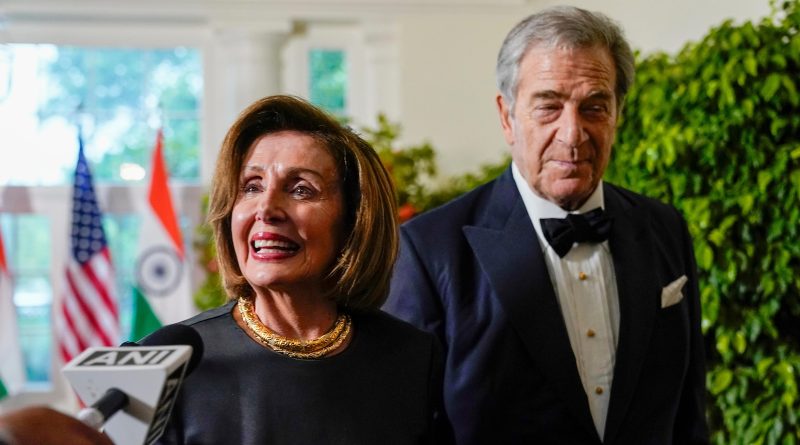Pelosi Urges an End to Political Threats and Violence in New Book
WASHINGTON — WASHINGTON (AP) — Nancy Pelosi briefly believed she might have passed away on Jan. 6, 2021.
Less than two years later, the peril of political violence would target her husband at their residence.
“Where is Nancy? Where is Nancy?”
That was the disturbing query the intruder asked Paul Pelosi before striking the then-82-year-old over the head with a hammer in their San Francisco residence. It resembled the menacing taunts of the rioters roaming the corridors of the Capitol shouting “Nancy, Nancy” on Jan. 6.
The common thread of escalating political language and violence in American public life acts as the introduction and conclusion of Pelosi’s latest book, “The Art of Power, My Story as America’s First Woman Speaker of the House.”
Pelosi recounts her nearly four-decade legislative track record in Congress but also provides a rare public insight into the private devastation surrounding the assault on her husband. Through this, she issues a serious caution that the casual ridicule and imitation of political violence in America is deterring a generation from public duty.
“The current atmosphere of threats and attacks needs to cease,” Pelosi states.
“We should not urge individuals to engage in public life if it means endangering the safety of their families and loved ones.”
Pelosi’s book delves into familiar territory for those familiar with the 84-year-old’s career, ascending from “homemaker to House member to House speaker.” The determined California Democrat, the speaker emerita, is no longer in charge but is seeking reelection to the House this autumn.
She twice secured the speakers gavel, collaborated with seven presidents and, more recently, played a crucial role in persuading President Joe Biden to reconsider his choice to stay in the 2024 presidential race against Republican Donald Trump. Biden withdrew.
However, it is the initial and final chapters that introduce a new aspect to the Pelosi era, describing in personal and meticulous ways the toll that America’s violent streak is taking on civic life and public duty.
“I am unsure if we will ever feel secure,” she notes.
Penned well before the July assassination attempt on Trump, Pelosi’s evaluation of the nation’s perilous dialogue arrives after consecutive congressional shootings of Republican Rep. Steve Scalise and previously of Democratic former Rep. Gabby Giffords, and it functions as a parting caution in what could be among her final years in Congress.
Pelosi recalls her disbelief at being “pulled off the Speaker’s platform” and out of the House chamber by security on the afternoon of Jan. 6 as rioters instigated by Trump rampaged through the halls, some hunting for her.
“I can manage it,” she objected, informing U.S. Capitol Police she wished to remain and complete the work as Congress was certifying the 2020 election.
“Their response was abrupt,” she writes. “’No, you cannot.’”
After being swiftly escorted to safety at Fort McNair, she narrates huddling with Senate Republican Leader Mitch McConnell and Senate Democratic Leader Chuck Schumer, the three of them urgently contacting the Pentagon to dispatch National Guard troops to restore order at the Capitol. She portrays House Republican Leader Kevin McCarthy, a Trump loyalist, as nearly invisible.
So concerned about the rioters’ threats against Vice President Mike Pence hiding at the Capitol, she reached out and advised him, “Do not disclose your location.”
“It still took three hours from the time I was dragged out of the House chamber for the Guard to arrive at the Capitol complex,” she writes. “It took around three and a half hours to clear the rioters from the building.”
Later, examining the aftermath of shattered glass and splintered wood, she was informed of blood outside the Speaker’s Lobby. In various locations, including her office, the mob had “literally defecated on the floors and rugs,” she penned. “What was left behind was pure destruction.”
She remembered being in conflict zones, and in Kyiv at the inception of the Russian invasion she thought she might perish in Ukraine. “I briefly thought the same on January 6,” she wrote.
“When I became Speaker, I knew that I was making myself into a target,” she writes. “Nevertheless, our acceptance of the risk is something that is fundamentally different for our families.”
Less than two years later, she was roused in the middle of the night by the “Knock. Knock. Knock. Pound, Pound. Pound,” of the Capitol Police security detail at her door in Washington.
“The officers’ expressions were grim,” she writes.
“It’s Mr. Pelosi. He’s been attacked in your home.”
“Is he okay?”
“We don’t know.”
“Is he alive?”
“We don’t know.”
Pelosi recounts the whirlwind hours, frantic family phone calls and journey back to San Francisco, the hospital, the surgeries and the lengthy recuperation for her husband. Their youngest daughter remarked he resembled a bandaged-up Frankenstein.
Her son, Paul Jr., went to the family’s home to vacuum up the broken glass and clean up the blood. Her daughter Alexandra, who had been a high schooler when Pelosi first ran for Congress, told her, had she known what they were signing up for she would “never have given you my blessing.”
The assailant was tried, convicted and sentenced to prison. But Pelosi writes, the account of Paul’s attack would not fade.
“Our home remains a heartbreaking crime scene,” she wrote.

